Jomon Journey of nawa to yajiri Japan Median Tectonic Line and Mercury Reduction
English is available after Japanese.
For other languages, please click here
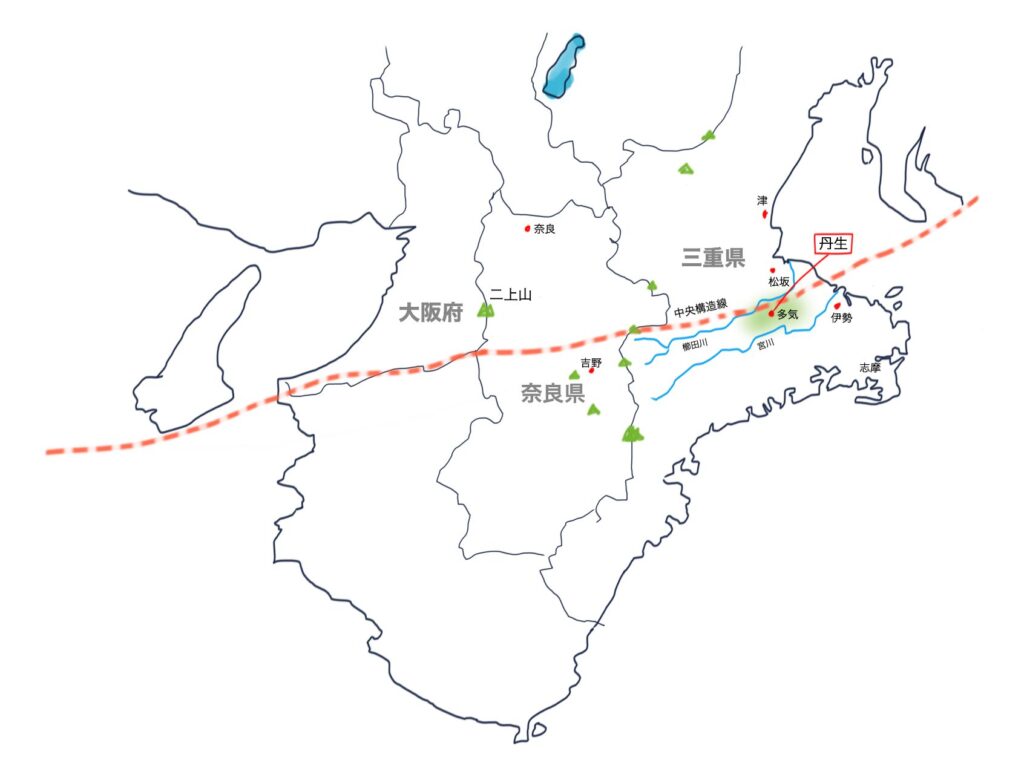
3月の中旬、伊勢・志摩方面に出張があり、土日まで滞在を伸ばしてこの地域の縄文をめぐろうと思った。
私たちは、何かの機会に縄文をめぐることを「ついで詣で」と称して楽しんでいる。たいていの地域に縄文遺跡はあるので、2、3日レンタカーを借りてその地域をまわるのだ。もちろん自腹で。滞在することで地域に還元したいし、小規模な博物館の来場者数に少しでも貢献したいという思いもある。だから、出張という機会は私たちにとって価値が高い。
たいていの自治体にはその地域の歴史や民俗資料を集めた展示施設があり、うまくいけば縄文時代の出土品に会うことができる。「うまくいけば」と書いたのは、必ずしも縄文時代がカバーされているとは限らないからだ。縄文時代に人口の多かった東日本であれば土器などに会える確率は高くなるが、その反対に人口が少なかったとされる西日本になると、会える確率は下がる。さて、伊勢・志摩エリアはどうだろうか?
早速インターネットで検索すると、和牛で有名な松阪市に草創期の土偶が出た粥見井尻遺跡という重要な遺跡があるものの、そのほかの情報がなかなか見つけられない。縄文の企画展はやっていても、土日は展示場所が休みだったりして、見に行くべきところがないのだ。当然のことながら伊勢神宮に関する施設は目立つので、いっそのことお参りに行こうかと思ったが、私たちにとって伊勢神宮はそれほどプライオリティが高いわけではなかった。
すると、地質が好きな廣川が「三重県には中央構造線があるじゃないか!」と目を輝かせて言う。中央構造線は、日本列島がアジア大陸にあった1億年前頃に、海洋プレートの沈み込みによってズレた日本一長い断層のことだ。長野県の諏訪湖の南から九州まで続くその一部が紀伊半島の北部を通っている。その大断層がどんな姿をしているのか、私にも興味があった。そこで、ひとまず伊勢市でレンタカーを借りて内陸側の多気という町をめざしたのだった。
なぜ多気かというと、スマホの地図アプリで「中央構造線」と検索したときに、多気町にある露頭が最初に表示されたからだ。また、情報を検索したときに、唯一出てきた復元土器の画像が多気町出土のものだった。だから、ここなら縄文に会えるかもしれないと期待を込めて最初に多気町の郷土資料館を訪ねたのだが、予想に反してそこには民具しか置かれていなかった。
受付の方に聞くと「縄文はたくさん出ているんですが、全部収蔵庫の中なんですよ。学芸員がいればご案内できるのですが、あいにく土曜は休みでして……」と大変申し訳なさそうにおっしゃっていた。
しかし、ここに来たのは決して無駄足ではなかった。入り口付近のラックに中央構造線の露頭情報が載った、館発行のニュースレターを見つけたのだ。ご丁寧に露頭の写真まで載っている。地図アプリのポイントと見比べると、同じ場所だとわかった。
その場所は多気町の丹生という地区にあった。周囲に森が広がり、製茶工場が一軒あるものの、ほかはめぼしいものがない寂しげなところだ。高さ20mほどの崖が幅100mくらいにわたって階段状に削られている。道中、砂利などの採石場をよく見かけたので、ここもかつてそうだったかもしれない。

その階段状の崖の左端に中央構造線の露頭はあった。重機で表面を削ったのか、そこだけ斜面が爪で引っ掻いたようにえぐれていて、黒みがかった青と白、赤茶色の斜めの地層が見えた。露頭に近づくと、かつて大きな圧力がかかった場所だけに、岩が細かく砕けた状態になっており大変もろい。慎重に足場を確かめながら登ろうとしてもズルッと滑る箇所があり、危険なことこの上ない。
安定して立てる場所までいき、いちばん目立つ赤い筋のような地層を見ると、明るめの茶色をしていて、地層というよりは地面に滲んだシミのように見えた。手でさわると、ちょっとした力で簡単に砕けてしまう。それはすり鉢でつぶしたらすぐに粉になりそうなやわらかさでもあった。
そのとき、ふと、これは西日本で赤の原料として使われる水銀朱なのではないかと思った。その色が赤彩土器などに見られる赤の色に似ていたからだ。確信は持てないが、もしそうなら有毒なのだろうか?

水銀朱について知りたくなった私たちは、丹生の西側にある勢和地区の郷土資料館が鉱物の展示に詳しいことを知り、そこを訪れた。しかしそこで最初に迎えてくれたのは、なんと縄文土器だった。
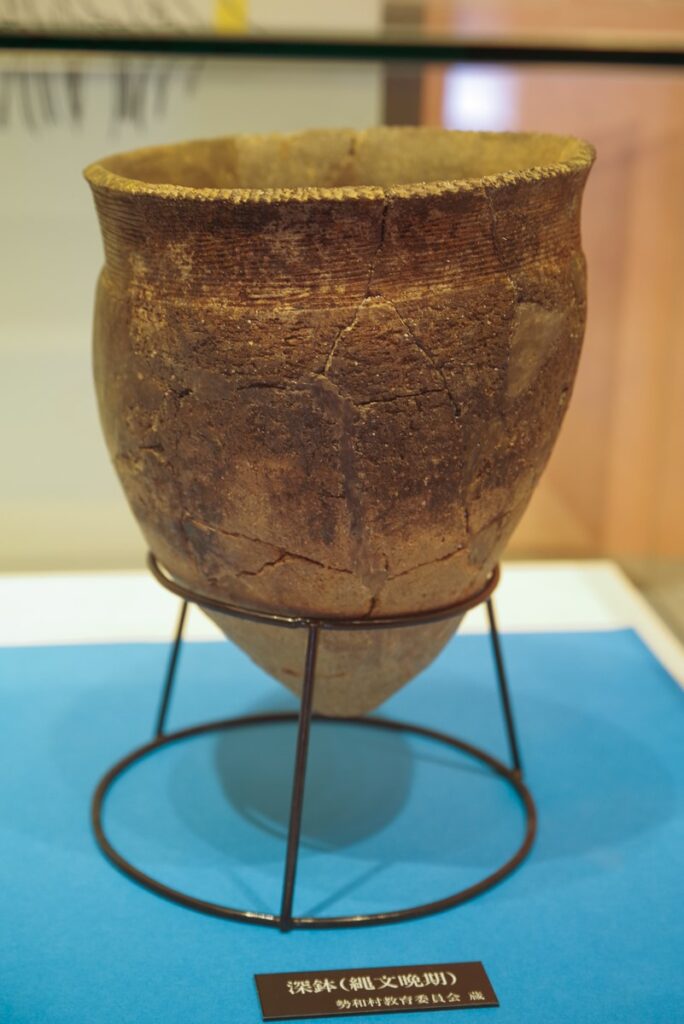
左右の膨らみ方が違うゆがんだ土器だ。土器の口の周りに幾筋もの条痕文が施され、縁に刻み目がついているほかは、装飾的な要素に乏しい。とはいえ、縄文時代のものが展示されているということだけでとても嬉しく、展示ケースに張り付きながらまじまじと見てしまった。
このシンプルさが西日本の土器だなあと思う。西日本の土器は、晩期になるとどんどん無文化していく。表面をなでたり削ったりする方向にいくのである。西から始まった弥生時代の土器がつるりとした器面に着彩で変化をつけたように、すでに弥生時代的な感性が始まっていることが土器を見ても感じられる。
もうひとつ嬉しい発見があった。なんと、多気町は60箇所の縄文遺跡が出ている三重県随一の縄文密集地帯だったのだ。あまり期待していなかった三重の縄文旅だが、思いがけず縄文の核心地に来てしまったようだ。


展示室には、水銀朱の原石をすりつぶすのに使われた石皿とすり石の実物が展示されていた。着色された土器などはあまり出ていないのか、朱色がわずかに残る土器片が4点展示されているばかり。しかし、それは2、3cmほどの大きさでも十分にわかるほど鮮やかな朱色をしていた。
水銀朱の原料となる鉱物は「辰砂」という。辰砂という漢字は、この鉱物の一大産地である中国の湖南省辰州に由来するらしいが、混じり気のない純粋なものは「丹」と呼ばれる。つまりあの中央構造線の露頭があった丹生は、名前からして「辰砂が生まれるところ」なのだった。
縄文時代から用いられてきた赤の顔料には、ベンガラと辰砂があるが、旧石器時代から使われてきたベンガラが黒ずんだ赤色であるのに対し、辰砂を精製した水銀朱は鮮やかな朱色をしている。ともに漆や膠と混ぜて祭祀用の土器や装身具の櫛などの着色に使われているが、辰砂で塗られた器などはハッとする明るさがある。

たとえば、青森県八戸の是川中居遺の漆塗り土器(縄文晩期)は、ベンガラ漆の上に北海道産の水銀朱を重ね塗りした状態で出土している。その朱色をみると、経年変化しているとはいえ、数千年の時を経ても失われない輝きに驚かされる。この発色の良さは、赤という色にこだわってきた縄文時代の人々を限りなく魅了したのではないだろうか。
しかし、辰砂は、酸化鉄のベンガラに比べてどこでもとれるものではない。日本列島における辰砂の産地は、前述した北海道のほか、まとまった量が出るのは、丹生や隣接する奈良県の大和地方など中央構造線に沿った地域に限られるのだ。その中でも埋蔵量が豊かな丹生の水銀は、古代には「伊勢水銀」と呼ばれ天皇に献上される産品だったらしい。中世になると丹生の辰砂の採掘はますますさかんになり、朝廷や摂関家のもとで水銀を専門に取り扱う日本唯一の「水銀座」と呼ばれる専門集団が組織されていく。
その頃の辰砂(水銀朱)は、漆器や朱肉のほか、薬、そして精製した水銀を触媒として仏像の表面を彩る鍍金に使われ、庶民が手にすることのできない貴重なものだった。最初の郷土館でもらったニュースレターによると、源平合戦の余波で焼失した奈良の大仏の再建にこの地域の辰砂が使われたそうだ。また、その大仏の補修用の水銀を献上した人物は、大中臣氏といい、伊勢神宮の祭主・大宮司を世襲する家柄でもあったという。丹生の水銀権益に伊勢神宮が関係していたことは、とても興味深い。思った以上に、辰砂の朱色や錬金術のもたらす力は、古代・中世の政治や宗教、経済に影響を与えていたのだ。やはり伊勢神宮に行くべきだろうか……。
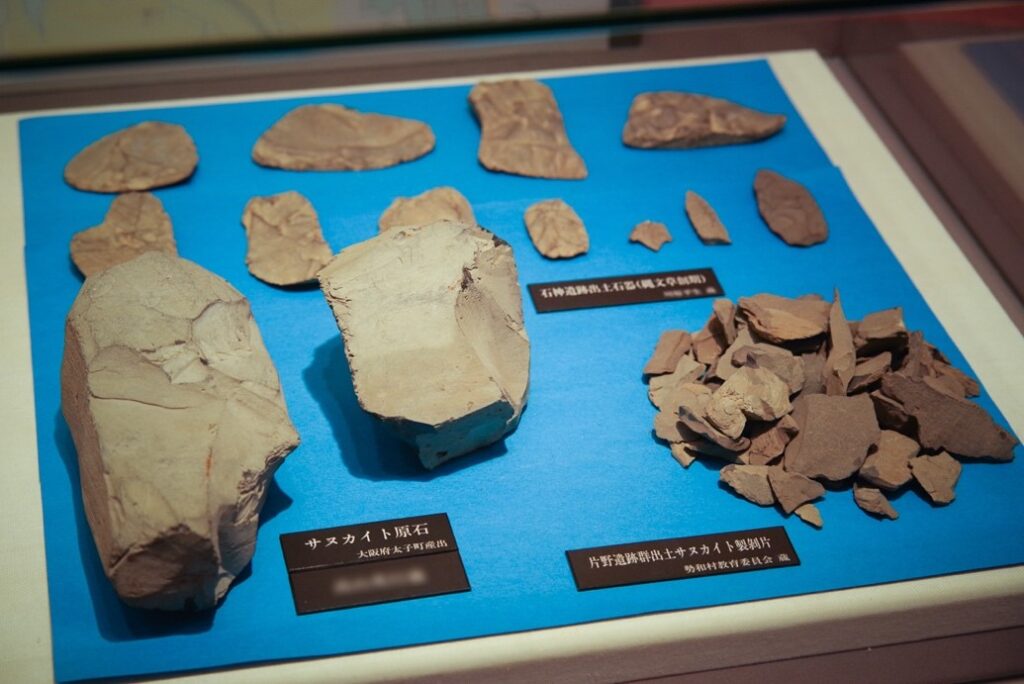
隣のコーナーには、サヌカイト(讃岐石)の原石やそれらを加工した打製石器が展示されていた。それを見て「あっ」と思った。西日本の縄文時代を代表する石器の原料といえば、サヌカイトである。3年前に隠岐諸島に行く旅の途中に、奈良と大阪の県境にあるサヌカイトの原産地、二上山の博物館に立ち寄ったことを思い出した。土地勘がないので気がつかなかったが、多気町を流れる櫛田川の源流部の山を越えると、そこは奈良の吉野であり、さらにその先にサヌカイトの山が控えているのだ。
旧石器時代に石器としての使用が始まり、縄文時代に近畿地方を中心に北陸や東海、山陰にまで普及した鋭利な石、サヌカイト。高密度で硬く、良質なものは打ち鳴らすと鉄琴のような音がする。鉄が登場するまで西日本の狩猟採集文化を支えてきたのは、そのような金属の響きを持つ石だった。
二上山からある程度近い多気は、西側の文化がサヌカイトとともに入ってきやすかったのではないだろうか。何よりもここでは辰砂がとれる。価値ある辰砂の色によって物々交換が成立しやすく、赤い色を求めて各地から人が訪れる。多気に縄文時代の遺跡が多く出ているのは、そんな理由が考えられないだろうか。その頃の痕跡が残っていたら、是非見てみたいものだ。
ちなみにサヌカイトもまた、中央構造線沿いに特徴的に分布する石である。辰砂といいサヌカイトといい、三重の縄文旅は中央構造線につながっていく。ここでは地球のプレート活動と縄文時代の暮らしが見事にリンクしているのである。私たちは、現代の暮らしではなかなか見えてこない、大地と人とのダイナミックなつながりに惹かれて旅をしているのだ。
※ちなみに辰砂は熱すると有毒な水銀に。自然にある状態ではそれほど危険なものではないらしい。
草刈朋子:文 廣川慶明:写真
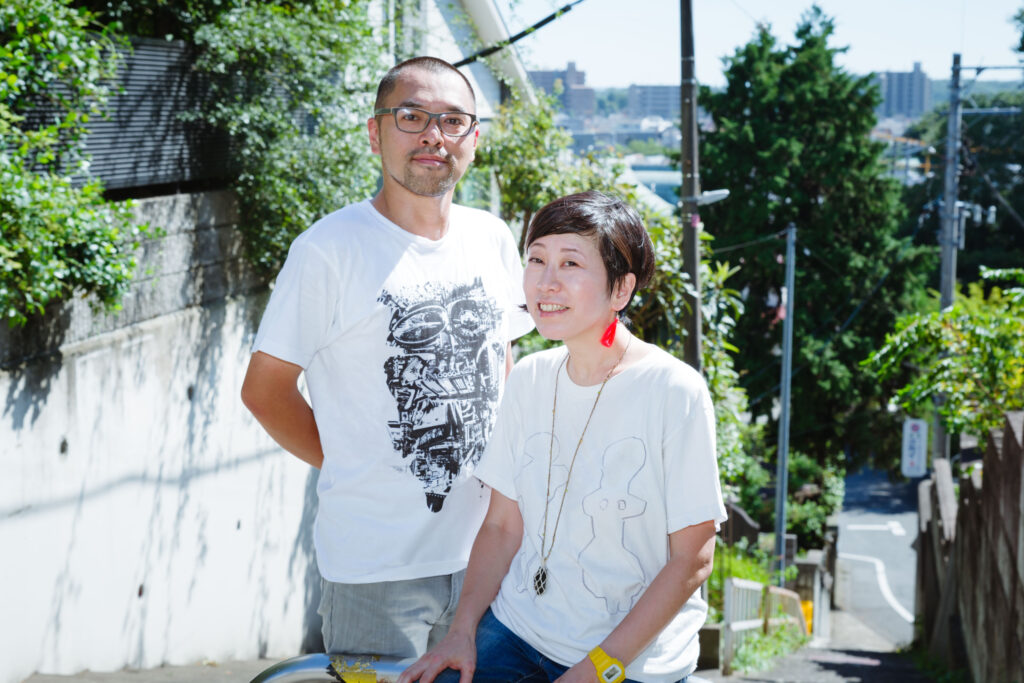
縄と矢じり
文章担当の草刈朋子と写真担当の廣川慶明による縄文探求ユニット。ともにNPO法人jomonismのメンバーとして活動するほか、全国の縄文遺跡と考古館や郷土館をめぐる縄文旅をしながら各地の縄文のカタチ、環境から読み解ける先史時代の価値観を探求中。
http://nawatoyajiri.com

In mid-March, we had a business trip to the Ise/Shima area and decided to extend our stay until Saturday and Sunday to explore the Jomon culture of this area.
We enjoy taking advantage of any opportunity to visit Jomon sites, calling it a “tsuide-moude”. Most areas have Jomon sites, so we rent a car for a couple of days and tour the area. Of course, I pay my own way. We want to give back to the community by staying there, and we also want to contribute as much as possible to the number of visitors to our small museum. So the opportunity to travel on business is highly valuable to us. We are also grateful to our understanding clients.
Most municipalities have exhibition facilities that collect local history and folklore materials, and if all goes well, visitors will be able to see artifacts from the Jomon period. I say ” if all goes well ” because the Jomon period is not always covered. If you are in eastern Japan, where the population was large during the Jomon period, the probability of seeing pottery and other artifacts will be higher, but in contrast, if you are in western Japan, where the population is believed to have been small, the probability of seeing such artifacts will be lower. How about the Ise/Shima area?
A quick Internet search revealed that Matsusaka City, famous for its wagyu beef, has an important archaeological site called the Kayumi-Ijiri Ruins, where a clay figurine from the pioneer period was found, but other information was hard to find. Even if there is a special exhibition on Jomon, the exhibition site is closed on Saturdays and Sundays, and there is no place to go to see it. Naturally, facilities related to the Ise Jingu Shrine were prominent, and we thought about visiting the shrine, but the shrine was not a high priority for us.
Then, “Mie Prefecture has the Median Tectonic Line!” says Hirokawa, a geology buff, with a twinkle in his eye. The Median Tectonic Line is the longest fault line in Japan that was displaced by the subduction of oceanic plates around 100 million years ago, when the Japanese archipelago was on the Asian continent. Part of it runs from south of Lake Suwa in Nagano Prefecture all the way to Kyushu, and runs through the northern part of the Kii Peninsula. I was curious to see what the great fault looked like. So we rented a car in Ise City and headed for the town of Taki on the inland side of the peninsula.
The reason why Taki is so important is that when I searched for “Median Tectonic Line” on my smartphone’s map app, the outcrops in Taki Town were the first to appear. Also, when I searched for information, the only image of reconstructed earthenware that came up was one excavated in Taki Town. Therefore, I first visited the local museum in Taki Town with the hope that I might be able to see the Jomon here, but contrary to my expectations, I found only folk artifacts there.
When I asked the receptionist, he said apologetically, “We have a lot of Jomon artifacts out there, but they are all in storage. If we had a curator, we could show you around, but unfortunately, they are not available on Saturdays…” he said very apologetically.
However, it was not a waste of time to come here. On a rack near the entrance, I found a newsletter published by the museum that contained information on outcrops of the Median Tectonic Line. It even includes photos of the outcrops. Comparing it with the point on the map app, I found it to be the same place.
The place was located in a district called Niu in the town of Taki. The area was surrounded by forests, and although there was one tea factory, there was nothing else of note in the area. A 20-meter-high cliff was carved into a 100-meter-wide staircase. We often saw quarries of gravel and other materials along the way, so this may have once been a quarry as well.

The outcrop of the Median Tectonic Line was on the left edge of the stepped cliff. The outcrop was scratched by heavy machinery, and the slope was gouged out as if by fingernails, revealing a sloping stratum of blackish blue, white, and reddish brown. As we approached the outcrop, we saw that the rock was very fragile because it had once been under great pressure and was in a state of being broken into small pieces. Even though we carefully checked our footholds as we climbed, we found ourselves slipping and sliding in some places, making the climb extremely dangerous.
When I reached a stable place where I could stand and looked at the most prominent red streak-like formation, it was light brown in color and looked more like a blotch on the ground than a formation. When I touched it with my hand, it crumbled easily with the slightest force. It was also soft, as if it would turn to powder as soon as it was crushed in a mortar and pestle.
At that time, it occurred to me that this might be mercury vermilion, which is used as a raw material for red in western Japan. The reason was that its color was similar to that of the red color found in red-colored earthenware. I could not be sure, but if so, was it toxic?

Wanting to learn more about mercury and vermillion, we visited the local museum in the Seiwa district on the west side of Niu, which we learned was well versed in exhibiting minerals. But the first thing that greeted us there was a Jomon earthenware vessel.

It is a warped earthenware vessel with different bulges on the left and right sides. The mouth of the vessel was decorated with stripes and the rim was incised, but there were no other decorative elements. Nevertheless, I was delighted to see a Jomon-era vessel on display, and I stuck to the display case to take a closer look at it.
I think this simplicity is the earthenware of western Japan. In the later stages of the production of earthenware in western Japan, the pottery became more and more uncultured. The surface of earthenware in western Japan became more and more uncultured in the later stages, and the direction was toward the direction of smoothing and scraping the surface. As earthenware of the Yayoi period, which began in the west, had a smooth surface that was varied by coloring, the Yayoi sensibility had already begun to develop.
There was another exciting discovery. Taki Town has 60 Jomon sites, making it the most Jomon-dense area in Mie Prefecture. I had not expected much from my trip to Mie, but it seems that I unexpectedly came to the heart of the Jomon region.


On display in the exhibition room were actual stone plates and rubbing stones used to grind raw mercury vermilion. There were not many colored earthenware vessels or other artifacts, or perhaps only four pieces of earthenware fragments with a slight vermilion color remaining were on display. However, the vermilion color was vivid enough to be recognized even at a size of a few centimeters.
The mineral from which mercury vermilion is made is called “cinnabar”. The Chinese character “cinnabar” is said to be derived from Chenzhou in Hunan Province, China, a major production center of this mineral, and the pure, unadulterated form is called “丹”. In other words, 丹生(Niu), where the outcrop of the Median Tectonic Line was located, is “the place where cinnabar is born,” as its name implies.
Bengara and cinnabar have been used as red pigments since the Jomon period. Bengara, which has been used since the Old Stone Age, is a dark red color, while mercury vermilion, which is refined from cinnabar, is a bright vermilion color. Both are mixed with lacquer and glue and used to color ritual earthenware and ornamental combs, but vessels painted with cinnabar have a striking brightness.

For example, the lacquered earthenware (Late Jomon period) from Korekawa Nakai-eto, Hachinohe, Aomori Prefecture, was excavated with a layer of Hokkaido mercury vermilion overlaid on top of bengara lacquer. The vermilion color of these vessels is surprisingly brilliant, even after several thousand years of aging. This coloration must have endlessly fascinated the people of the Jomon period, who were obsessed with the color red.
However, compared to bengara, an iron oxide, cinnabar is not found everywhere. In addition to the aforementioned Hokkaido, cinnabar in the Japanese archipelago is produced only in areas along the Median Tectonic Line, such as Niu and the Yamato region of neighboring Nara Prefecture, where large amounts are produced. The rich reserves of mercury in Niu were called “Ise mercury” in ancient times and were offered to the emperor. In the Middle Ages, mining of cinnabar in Niu became more and more prosperous, and a specialized group called “Sui-ginza,” the only one in Japan specializing in mercury, was organized under the Imperial Court and the regents.
At that time, cinnabar (mercury vermilion) was used for lacquerware, vermillion ink, medicines, and plating to color the surface of Buddhist statues using refined mercury as a catalyst, and was a precious commodity not available to the general public. According to a newsletter given to me at the first local museum, cinnabar from this area was used in the reconstruction of the Great Buddha statue in Nara, which was destroyed by fire in the aftermath of the Genpei War. The man who donated the mercury for the repair of the Great Buddha was called Ohnaka Tomiuji, who was also a family member who succeeded to the position of Grand Shrine Chief and Priest of Ise Jingu Shrine. It is very interesting to note that the Ise Shrine was related to the mercury interests in Niu. More than I expected, the vermilion color of cinnabar and the power of alchemy had an influence on politics, religion, and economy in ancient and medieval times. Perhaps I should still visit the Ise Jingu Shrine…

In the next section, there was a display of rough sanukite (Sanuki stone) and stone tools made from them. When I saw them, I was surprised. Sanukite is the most representative stone tool of the Jomon period in western Japan, and I recall that three years ago, on a trip to the Oki Islands, I stopped by a museum in Nijo Mountain, the original home of sanukite, located on the border of Nara and Osaka prefectures. I was not aware of it because I was not familiar with the area, but when I crossed the mountain at the headwaters of the Kushida River that runs through Taki Town, there was Yoshino in Nara and the sanukite mountain lay ahead.
Sanukite is a sharp stone that began to be used as stone tools in the Paleolithic Age and spread to the Kinki region, Hokuriku, Tokai, and San-in region in the Jomon Period. It is dense and hard, and a good quality one sounds like a metallophone when struck. Until the advent of iron, it was stones with such a metallic sound that supported the hunter-gatherer culture of western Japan. Taki, which is somewhat close to Mt. Nijo, may have facilitated the entry of western culture along with sanukite. Above all, cinnabar can be obtained here. The valuable color of cinnabar makes it easy to barter for it, and people come from all over for the red color. This may be the reason why there are so many ruins from the Jomon period in Taki. If there are any traces left from that period, I would love to see them.
Incidentally, sanukite is another stone characteristically distributed along the Median Tectonic Line. Cinnabar and sanukite, as well as the triple Jomon journey, are connected to the Median Tectonic Line. Here, the earth’s plate activity and Jomon life are beautifully linked. We are traveling because we are fascinated by this dynamic connection between the earth and its people, which is difficult to see in modern life.
※By the way, cinnabar becomes toxic mercury when heated. Apparently, it is not so dangerous in its natural state.
Tomoko Kusakari : Text, Yoshiaki Hirokawa : Photo
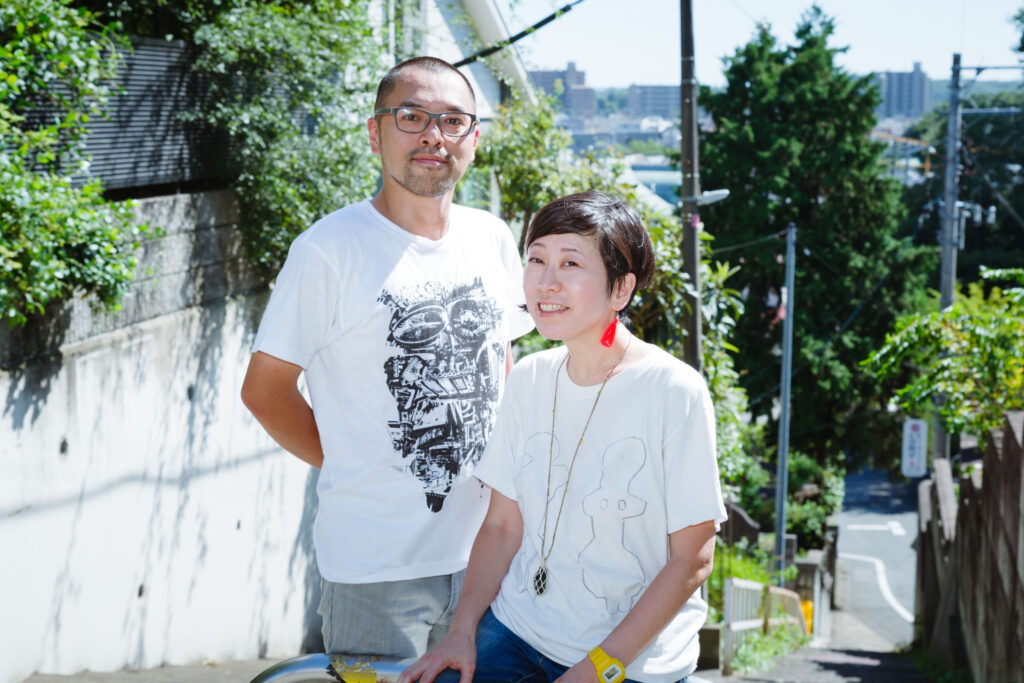
nawa to yajiri
(it means “Rope and Arrowhead”)
A unit for exploring the Jomon by Tomoko Kusakari (writing) and Yoshiaki Hirokawa (photography).
In addition to working as members of the NPO Jomonism, they also travel around Japan visiting Jomon ruins, archaeological sites and local museums, exploring the prehistoric values that can be deciphered from the forms and environments of the Jomon.
http://nawatoyajiri.com